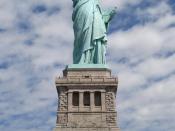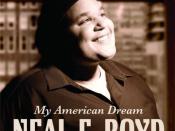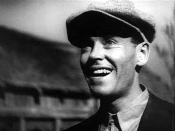America: a land of endless wealth, and the dream; a dream of endless opportunity, is not depicted as such in the books The Grapes of Wrath and The Great Gatsby. The Dream is instead portrayed as hypocritical in the assumption that spiritual satisfaction is always accompanied material gain.
In The Great Gatsby America is shown as a land of dreams that is undeniably corrupted by materialism to such a degree that even the image of god (the blue eyes of Dr. Eckleburg be) was looking "out⦠from a pair of enormous yellow spectacles" (Fitzgerald 23) (the yellow being a symbol of materialism). Following the theory that yellow is symbolic for the corruption of wealth. It could be hypothesized that Daisy is the personification of a tarnished American dream. Just as Daisy is "high in the white palace the king's daughter, the golden girl" (Fitzgerald 120), so the American dream hides the corruption of materialism within its purity.
Unlike The Great Gatsby, The Grapes of Wrath does not focus on the corruption of the Dream as much as it focuses on the corruption of the people withholding the Dream. California is a Garden of Eden, but it is a garden with "guards with shotguns patrolling the lines so a man might not pick an orange for a thin child, oranges to be dumped if the price was low" (Steinbeck 319). The Joads were not "son[s] of god" (Fitzgerald 99); they did not desire an intangible dream, the Joads' desire was simple: land and food. But because of the selfishness of others to such a degree that "children dying of pellagra must die because a profit cannot be taken from an orange" (Steinbeck 477), the dream that "life should be better and richer and fuller for everyone" (Adams) is unfulfilled.


